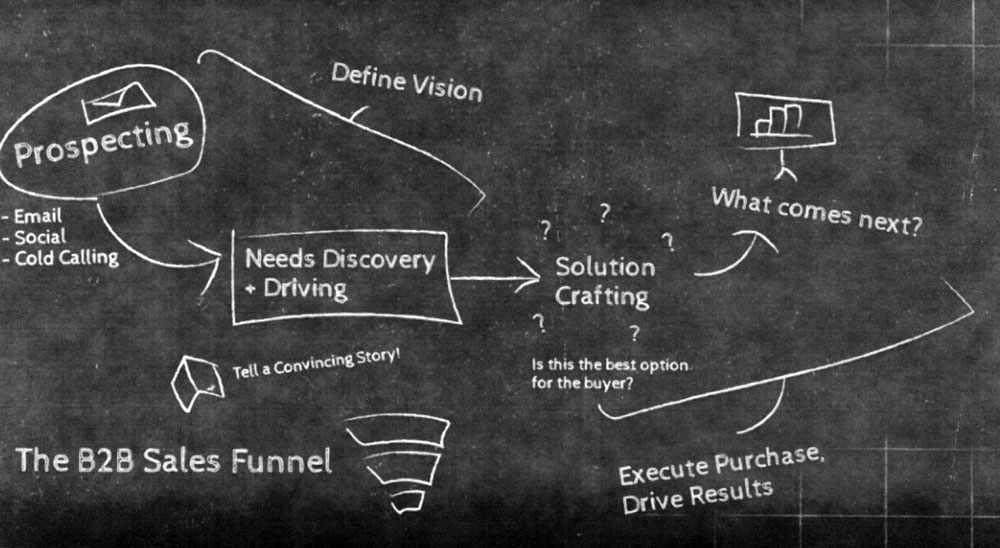How does your company measure sales success? Is it a full funnel? Is it the number of leads generated? Is it the number of sales closed in a month? No question, metrics are an important measure of success. But a measure of what success?
What sales and marketing strategy have you put in place in your organization? And how do you measure whether it’s working? Picking and measuring the right sales strategy is the focus of today’s blog.
Strategy should be driven by what you are trying to accomplish—your sales goals, and how they affect your company’s performance. I encourage you to take a hard look at what numbers you set in the first place. Are they realistic? Are salespeople meeting them? If you don’t have a dedicated sales staff, who is responsible for generating new business? Is it you the CEO/owner?
I’m convinced a simpler understanding of the sales process is a great place to start. When I ask a new client who is struggling to grow the business “What’s standing in the way?”
He or she often states, “We need more sales.”
“Yes, but what kind of sales?” I ask.
“Profitable sales,” they say.
“And how will we measure that?” I ask.
That’s when I get the blank stare. The normal answer, “That’s why I hired you!”
So, let’s start right there. If you’re trying to grow your business and want to improve your sales, let’s consider establishing a simple strategy as a common starting point. Can you gain new customers similar to your existing customers, or is there no room for growth? Will you have to jump to a new category of customer prospects?
It is easiest to find customers from your existing base. So, let’s limit our discussion here to growing your customer base from new customers that are similar to your existing customers.
Have you carefully defined your existing customer? Is there a customer sweet spot your company is ideally suited to serve? How easy is it to locate that customer? Will you get them from a trade association list, by cold calling, or from referrals? What geography will you pick from? And how will you reach out to them? What marketing tools or methods will you be able to use easily to reach them?
Next, have you refined the messages they need to hear about your company and its services/products? I find at this point it’s a good idea to loop back to some thinking or discussion with your company leaders as to what customers are saying is the reason they buy from you. Here’s a helpful analysis tool that you might want to use.
Have a Sales Process in Place
Now that you have defined or redefined why your customers buy from you, it’s time to establish a process to keep track of where you are with the customer prospect. Most companies don’t have a step-by-step sales process—but they should! You could get by with a conceptual understanding of the major milestones needed to lead more customers to buy from you as a starting point.
While going through my files, I ran across a clever diagram that maps the process in a chalk sketch that could have been drawn on a blackboard.
I can’t credit the author since it looks like I just made a screenshot from the Internet some time ago. My apologies (if you know who created this, let me know so I can credit them in the future). The screenshot is similar to the process we use at Corporate Images to get everyone on the same page in sales. It doesn’t explain all the intricacies, but from it you get the idea that filling the B2B sales funnel is a complex set of tasks. But as a strategic directive, I think it works well. If this is helpful, let me know in the comments section below.

If you’d like to institute a better sales procedure in your company, I’d be glad to help you fill in all the gaps. I can show you a ten-step process we call the Way of Selling that fleshes out this diagram in repeatable, defined stages in the B2B sales process.
When you have the procedure in place for how each new prospect will move through your sales and marketing process, it’s time to start quantifying the sales funnel process. How many new customers do you need? How many sales prospects will it take to gain a customer? How do you define “customer” (if they buy once, by sales volume, and so on). How will you measure the progress of the prospects that are in your funnel?
One caution. Aim carefully at realistic numbers. In the excitement of starting a new sales initiative, don’t pledge to generate more leads than is practical or even possible. In addition to the disincentive of overpromising and under delivering, too many leads can be a problem if you’re not set up right. A flood of leads could mean that otherwise qualified leads fall through the cracks and are not contacted to be served.
Five Key Data Points
Here are some data points that Christopher Ryan, CEO of Fusion Marketing Partners, once posted in a blog. They are still valuable measures of sales success that you may want to consider using.
- Monthly revenue target—your monthly sales goal from all revenue sources
- Average sales price (ASP)—the average revenue contribution from each new sale
- Opportunity-to-sale ratio—the percentage of pipeline opportunities that you close
- Qualified lead-to-opportunity ratio—how many qualified leads it takes to produce one opportunity
- Inquiry-to-qualified-lead ratio—how many inquiries it takes to produce a qualified lead
Want more Fresh Ideas like this? Sign up for our twice monthly newsletter. Or see some of our other blog posts archived here in our blog. Or Follow Us at our LinkedIn Company page.
Need some specific help on your sales program? Just contact us. We welcome your contact.










0 Comments